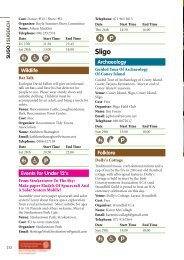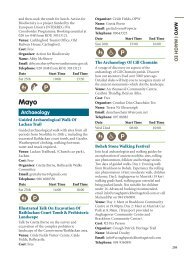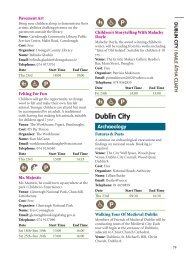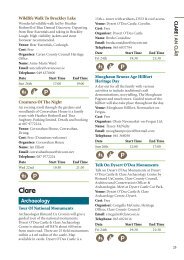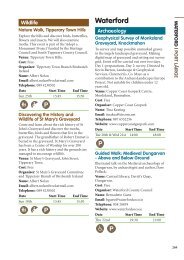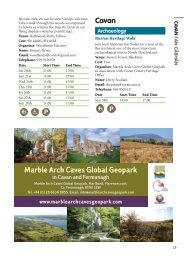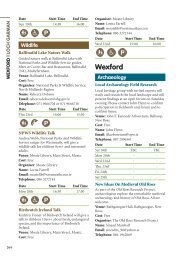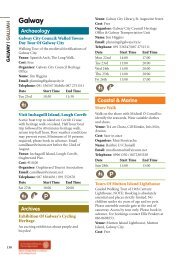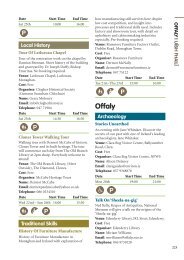10 Don'ts for Press Releases Writing a Press Release - Heritage Week
10 Don'ts for Press Releases Writing a Press Release - Heritage Week
10 Don'ts for Press Releases Writing a Press Release - Heritage Week
Create successful ePaper yourself
Turn your PDF publications into a flip-book with our unique Google optimized e-Paper software.
<strong>10</strong> Don’ts <strong>for</strong> <strong>Press</strong> <strong><strong>Release</strong>s</strong><br />
• Don’t type your press release in capitals<br />
• Don’t type your press release in italics<br />
• Don’t type your press release on both sides of a page<br />
• Don’t fail to proofread your release – or, better still, have it proofed by someone else<br />
• Don’t use clichés<br />
• Don’t use padding (‘with regard to’ ‘in the context of’)<br />
• Don’t send it late (some provincial papers stop taking copy much earlier in the week than you might<br />
think – check with them)<br />
• Don’t send it to the wrong person – or the right person with their name wrongly spelled<br />
• Don’t use bold type to emphasise points in your release<br />
• Don’t open quotation marks and <strong>for</strong>get to close them<br />
<strong>Writing</strong> a <strong>Press</strong> <strong>Release</strong><br />
The hope animating the writer of any press release is that, when it’s finished, the release might appear in<br />
the newspaper, unchanged. If that is to happen, the press release must read the way stories in that paper<br />
read.<br />
Obvious In theory, yes. In practice, no.<br />
Some organisations send four page press releases, filled with words like ‘infrastructure’, ‘peripherality’ and<br />
‘subsidiarity’ to broadsheet and tabloid newspapers. The end result is that the stories rarely appear in the<br />
tabloid papers: because they’re not presented in the way tabloid newspapers write their stories, which is:<br />
• Short/ not long<br />
• Accessible, not obscure.<br />
There is a strong case <strong>for</strong> sending different types of press releases to different media. A story presented as<br />
a radio script and written in the spoken word has a much better chance of getting on radio than the same<br />
story presented in the written word.<br />
A number of key principles are common to all good press releases:<br />
1. A good press release has a good headline<br />
2. A good press release answers the key questions in the first paragraph<br />
3. A good press release uses active verbs and first degree words<br />
4. A good press release keeps the Fog Index in mind<br />
1. A Good <strong>Press</strong> <strong>Release</strong> Has a Good Headline<br />
Each and every day, we are all bombarded, inundated with in<strong>for</strong>mation from radio and the headline on a<br />
news story is like a free sample. It gives us a flavour of what the overall story is about. If the headline does<br />
not grab us, we are unlikely to read the rest of the story. There<strong>for</strong>e, it may not matter how good the story is<br />
if it has a poor headline on top.<br />
This is a poor headline:<br />
Infrastructural Upgrade Enabled By EU Allocation Of €300,000 Following Campaign Related To<br />
Peripheral Areas Policy Directive<br />
Here’s what’s wrong with it:<br />
• It’s too long. 16 words is twice too long. A great headline can be spoken in one breath.
• It’s full of what Hazlitt called the ‘big, grey words of the lexicon’. If you sit in a bus and listen to<br />
ordinary people talking, you’ll listen a long time be<strong>for</strong>e you hear words like ‘infrastructure’ or ‘policy<br />
directive’.<br />
Headlines should always be in the language of the reader not the writer.<br />
• It’s passive. ‘Enabled by …’ is an indirect, passive way of saying something.<br />
• It’s in the past tense, so it sounds historic rather than newsy<br />
This is a good headline:<br />
New Road Cuts Traffic Jams In Half<br />
• It’s short. Tells the story in seven words<br />
• It’s in vivid simple language<br />
• It’s active: ‘Cuts traffic jams..’<br />
• It’s got human implications. (Most of us have been stuck in traffic jams.)<br />
• It’s in the present tense, so it’s newsy<br />
• (The future tense would work equally well: ‘New Road Will Cut Traffic Jams in Half’)<br />
• It’s imaginable. We can see traffic moving freely<br />
When you’re writing a headline, remember that there is no obligation on the reader to pay any attention to<br />
it. The obligation is on you to attract the reader. It’s pointless to say ‘but they should be interested in this’.<br />
There are no ‘shoulds’ in mass media. You have to attract and persuade people to read your story: they<br />
have a million and one alternatives. The onus is on the writer, not the reader. And that applies throughout<br />
the writing of your press release.<br />
2. A Good <strong>Press</strong> <strong>Release</strong> Answers the Key Questions in the First Paragraph<br />
Why<br />
For two reasons:<br />
• If you story gets into the paper, and another, bigger story comes along be<strong>for</strong>e it goes to print, they<br />
will edit your story. Under pressure, a sub-editor will simply chop off the end of it. So your story<br />
must be understandable, even if what follows the first paragraph were chopped off.<br />
• Readers are busy and distracted. They may not have the time to read every story to the end. So<br />
you want to deliver the key in<strong>for</strong>mation early, just in case.<br />
The key questions are:<br />
• What (is happening)<br />
• Who (is involved)<br />
• Where (is it happening)<br />
• When<br />
• Why<br />
3. A Good <strong>Press</strong> <strong>Release</strong> uses Active Verbs and First Degree Words<br />
This sentence uses the passive <strong>for</strong>m of the verb: ‘The town hall was occupied by protestors.’<br />
This sentence uses the active <strong>for</strong>m of the verb: ‘Protestors occupied the town hall.’<br />
Remember, if it’s a headline, don’t just go <strong>for</strong> an active verb, go <strong>for</strong> a present or future tense verb:<br />
‘Protestors Occupy Town Hall’ or ‘Protestors to Occupy Town Hall’<br />
Here’s the easiest way to remember this rule:<br />
• BAD: Man bitten by dog (passive, past tense)<br />
• GOOD: Dog bites man (active, present tense)<br />
FIRST DEGREE WORDS are the terms we automatically use:<br />
• Boat<br />
• Book<br />
• Face<br />
SECOND DEGREE WORDS are the terms we use when we want to be more varied or impressive:<br />
• Vessel<br />
• Volume/Tome<br />
• Countenance
In order to understand a second-degree word, we almost have to relate it to its first degree equivalent. In<br />
news stories – and in press releases – first-degree words are better, because they don’t make the reader<br />
work. Use of first-degree words is sometimes described as the KISS rule: Keep it Simple, Stupid!<br />
4. A Good <strong>Press</strong> <strong>Release</strong> keeps the Fog Index in mind<br />
The Gunning Fog Index is about sentence length. Based on observation of the pattern of attention given by<br />
readers to printed material, it suggests that the longer a sentence, the thicker the ‘fog’ through which the<br />
reader has to get the message.<br />
• 8 – <strong>10</strong> word sentences are clear and easy to understand<br />
• <strong>10</strong> - 15 word sentences are slightly less clear and easy to understand.<br />
• 15 – 25 word sentences mean that the fog is thickening<br />
• 25+ can mean the sentence becomes impenetrable.<br />
The following sentence, <strong>for</strong> example, has 67 words:<br />
‘through optimisation of mass media publicity opportunities while ensuring correct presentation of<br />
visual identification materials, it is possible to highlight opportunities available to potential<br />
beneficiaries of Structural Funds through the portrayal of successful projects already extant and at<br />
the same time alert members of the general public to the role played by the Member States<br />
together with the European Commission in the process of developing the regions.’<br />
It would be much more easily understood if it were broken into five or more sentences. (It would also help<br />
if it used first-degree words like ‘Logo’ instead of ‘visual identification materials’).<br />
A shorter sentence version might read like this:<br />
‘Successful projects are the best way to show what Structural Funds do. Potential beneficiaries get<br />
to see what opportunities exist. And the general public learns how the Commission and Member<br />
States are helping disadvantaged regions. These projects would be publicised in all media to<br />
make sure the message reaches everybody. The Structural Fund logo would always be used so<br />
people remember the name.’<br />
[Ends]




